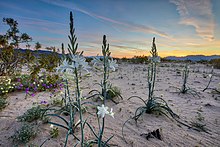bio.wikisort.org - Plant
Hesperocallis is a genus of flowering plants that includes a single species, Hesperocallis undulata, known as the desert lily or ajo lily.
| Hesperocallis | |
|---|---|
 | |
| Scientific classification | |
| Kingdom: | Plantae |
| Clade: | Tracheophytes |
| Clade: | Angiosperms |
| Clade: | Monocots |
| Order: | Asparagales |
| Family: | Asparagaceae |
| Subfamily: | Agavoideae |
| Genus: | Hesperocallis |
| Species: | H. undulata |
| Binomial name | |
| Hesperocallis undulata A.Gray, 1868 | |

It is found in the desert areas of southwestern North America, in Northwestern Mexico, California, and Arizona. The plant grows in Mojave Desert and Sonoran Desert habitats.
Taxonomy
In the APG III system, adopted here, Hesperocallis is placed in the family Asparagaceae, subfamily Agavoideae, since recent molecular systematic studies (Pires et al. 2004) have confirmed a close relationship with Agave.[1] Other classifications have included the species in its own family, Hemerocallidaceae, or placed it in the Hostaceae (Funkiaceae); both families are submerged into the Agavoideae in the APG III system.[2] As with many of the 'lilioid monocots', prior to the use of molecular evidence in classification, it was placed in the Liliaceae.
Uses
The bulbs of the desert lily are eaten by native peoples.[3]
References
- Stevens, P.F., Angiosperm Phylogeny Website: Asparagales: Agavoideae
- Chase, M.W.; Reveal, J.L. & Fay, M.F. (2009), "A subfamilial classification for the expanded asparagalean families Amaryllidaceae, Asparagaceae and Xanthorrhoeaceae", Botanical Journal of the Linnean Society, 161 (2): 132–136, doi:10.1111/j.1095-8339.2009.00999.x
- "American Indian Ethnobotany Database: Hesperocallis undulata". Archived from the original on 2012-02-15. Retrieved 2011-04-03.
- Pires, J. C., I. J. Maureira, J. P. Rebman, G. A. Salazar, L. I. Cabrera, M. F. Fay, and M. W. Chase. 2004. Molecular data confirm the phylogenetic placement of the enigmatic Hesperocallis (Hesperocallidaceae) with Agave. Madroño 51: 307–311.
- NCBI Taxonomy Browser
External links
- CalFlora Database: Hesperocallis undulata
- genus and USDA Plants Profile of Hesperocallis undulata
- Hesperocallis in the Flora of North America (treated as a member of the family Liliaceae); Distribution Map
- Hesperocallis undulata pictures
- BLM Desert Lily Preserve photo album
- links at CSDL, Texas
На других языках
- [en] Hesperocallis
[es] Hesperocallis undulata
Hesperocallis es un género monotípico de plantas que hoy pertenece a la subfamilia Agavoideae de las asparagáceas en sentido amplio. El género incluye una sola especie, Hesperocallis undulata, el "lirio del desierto", encontrada en áreas desérticas del sudoeste de Norteamérica.[ru] Гесперокаллис
Hesperocallis undulata — единственный вид рода Гесперокаллис (лат. Hesperocallis) семейства Спаржевые (лат. Asparagaceae). Обитает в пустынях на юго-западе Северной Америки.Другой контент может иметь иную лицензию. Перед использованием материалов сайта WikiSort.org внимательно изучите правила лицензирования конкретных элементов наполнения сайта.
WikiSort.org - проект по пересортировке и дополнению контента Википедии